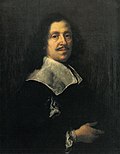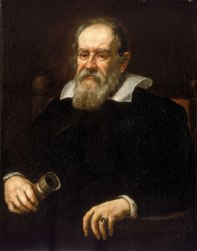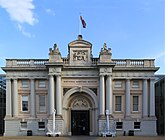Vaizdas:Galileo Galilei (1564-1642) RMG BHC2700.tiff

Didesnės raiškos iliustracija (2 964 × 3 765 taškų, rinkmenos dydis: 31,93 MiB, MIME tipas: image/tiff)
| Ši byla yra iš bendros Wikimedia Commons nemokamų resursų duomenų bazės, palaikomos Wikimedia Foundation organizacijos. Norėdami sužinoti licencijavimo smulkmenas, žiūrėkite paveikslėlio aprašymą | Į paveikslėlio aprašymą |
Aprašymas
| Justus Sustermans: Portrait of Galileo Galilei
|
||||||||||||||||||||||||||||
|---|---|---|---|---|---|---|---|---|---|---|---|---|---|---|---|---|---|---|---|---|---|---|---|---|---|---|---|---|
| Autorius |
artist QS:P170,Q974195 |
|||||||||||||||||||||||||||
| Pavadinimas |
label QS:Les,"Retrato de Galilei"
label QS:Lfr,"Portrait de Galilée"
label QS:Lml,"ഗലീലിയൊ"
label QS:Lnl,"Portret van Galileo Galilei (1564-1642) zittend in halffiguur, met een telescoop in zijn hand"
label QS:Lpt,"Retrato de Galilei"
label QS:Ltr,"Galilei Portresi"
label QS:Lit,"Ritratto di Galilei" |
|||||||||||||||||||||||||||
| Object type |
paveikslas object_type QS:P31,Q3305213 |
|||||||||||||||||||||||||||
| Žanras |
portretas |
|||||||||||||||||||||||||||
| Aprašymas |
English: Galileo Galilei (1564-1642) A half-length portrait, in old age, of the Italian mathematician, philosopher and astronomer, who was appointed court mathematician to the Medici dukes of Tuscany at Florence in 1610. He is dressed in black, wears a white beard and is seated in a chair holding a telescope in his right hand. His left hand rests on the arm of the chair and he wears a ring with a clear stone on his fourth finger. He faces forward towards the viewer. Galileo, though not first inventor of the refracting telescope in 1609, enhanced its power, which enabled him to see that the Moon had mountains and that Jupiter had satellites. His championship of the Copernican (Sun-centred) planetary system brought him into serious conflict with the Roman Catholic church, which forced him to make a public recantation and put him under restriction in later life, as noted by the poet John Milton, who met him in Florence in 1638 and recorded in his 'Areopagitica': 'There it was I found the famous Galileo, grown old, a prisoner to the Inquisition for thinking in astronomy otherwise than the Franciscan and Dominican licensers thought.' The artist was a Flemish painter and draughtsman who worked in Florence as court painter to the Medici. He was considered the foremost portrait painter in Italy, with a strong interest in Venetian Renaissance art. This is one of the last portraits of Galileo and several versions and/or copies were made. This one, painted for the Florentine Pandolfini family, may be the original, though there are other contenders. The principal evidence is the inscription on the back of the original canvas: 'No 51. / Galileo / da Giusto Sustermans / della Casa Pandolfini / a Firenza', while an old English label on the stretcher adds that it is 'the best known' portrait and 'That in the Pitti Palace is without hands and has all the appearances of a copy'. The longstanding Pitti version (no. 2397), which is otherwise the best known and often assumed to be the original is cut down all round, just showing the rim of the telescope at the bottom. NMM inspection in 1971 also concluded it was more likely to be a copy. The present painting has a near-intact provenance since 1833. It was purchased in Florence on 26 April that year for 534 pauli (£12 10s) including its fine Florentine frame, from the Marchesa Nimini: its previous history is not known, or whether the Marchesa had a family connection with the Pandolfini. The buyer was a long-resident English collector, the Revd John Sanford (d. 1855). He returned with his large collection to England in 1837 and subsequently put much on the market. The Galileo appears as no.51 (as added above the Italian inscription) in an 1838 printed catalogue of Yates, the dealer, with a reserve of £200 but it did not sell. It was exhibited at the British Institution in 1849 and passed with Sanford's remaining collection to his only daughter, who in 1844 married Frederick Methuen (later second Lord Methuen) of Corsham Court, Wiltshire, the whole becoming part of the larger Methuen collection. It was sold from Corsham at Christie's on 14 May 1920 (lot 38, for 58 guineas), the buyer being the 'Art Collections Association' and probably quickly passed to George H. Gabb, though exactly how is unknown. His collection - mainly of scientific instruments - was purchased and presented to the Museum by Sir James Caird early in 1937. At another Christie’s sale in 1920 he also purchased directly, again for 58 guineas, a pear-wood bust of Galileo from the Sanford holdings at Corsham (SCU0023) and was the immediate source of both the Museum’s other two Galileo oil portraits (BHC2699 and BHC2701), and another bust of him in bronze (SCU0022). The good 19th-century catalogues of the Sanford and Methuen collections are still at Corsham and the Sustermans is no 18. in Sanford’s manuscript catalogue raisonnee of 1847. Like much of his collection it was also recorded in a watercolour copy, also still at Corsham, made in Florence about 1835 by Giovanni Gozzini. The oil features in all three printed catalogues of the Methuen collection (c.1876-1903) and hung near the bust in the lower corridor at Corsham for over 45 years preceding its sale. Waagen, who also saw it in the house, briefly described the Sanford collection origins and noted the painting as 'From the Pandolfini family, for whom it was painted. Of lively conception and broad treatment'. ('Galleries and Cabinets of Art in Great Britain', 1857, p. 397). A more complete account is Benedict Nicolson’s well-illustrated 'The Sanford Collection', in the ‘Burlington Magazine’ (vol. 97, no. 628, July 1955, pp. 207-14), though neither he nor Corsham then knew where the painting was and the image included is from the Gozzini watercolour. NMM notes made in Florence in 1971 mention the Pitti having recently acquired another version of BHC2700 from the Rosselli del Turco collection (only then seen as a photograph in the German Art Institute there), but no further mention of this has been found and it may be a misunderstanding: a third was also noted as existing in Frankfurt. A fourth (exhibited at the B.I. in 1854) was in the Lansdowne sale at Christie's on 7 March 1930 and may be the same as that recorded on the RKD database as again passing through Christie's on 7 May 1995 though, curiously, also from the 'Marquis of Lansdowne, Meikleour House'. The last appears to be early and good, with a fragmentary Latin inscription. Nicholson in 1955 also noted one in the Torre al Gallo, Florence, but the present status and relationship of all these is not yet known to the Museum. The Bodleian Library, Oxford, also has an early copy (omitting the left hand) presented by Galileo's disciple, Vincenzo Viviani, in 1661. Confusion is not helped by the fact that two separate Sustermans portraits of Galileo are sometimes treated as versions of each other, whereas they are somewhat different. The earlier one of 1636, in the Uffizi and of which BHC2701 is a copy, is more dynamic in pose, and probably shows him standing, compared to this later seated ‘Pandofini’ one. For the most modern Italian commentary see Federico Tognoni in 'Iconografia Galileiana' (Le Opere di Galileo Galilei': Appendice, vol 1, Florence, 2013) in which it is item D22, pp.70-71, as by 'Justus Suttermans(?)'. |
|||||||||||||||||||||||||||
| Depicted people |
Galilėjus |
|||||||||||||||||||||||||||
| Data |
circa 1640 m. date QS:P571,+1640-00-00T00:00:00Z/9,P1480,Q5727902 |
|||||||||||||||||||||||||||
| Technika |
oil and wood on canvas |
|||||||||||||||||||||||||||
| Matmenys | Painting: 867 mm x 686 mm; Frame: 1250 mm x 1065 mm x 90 mm | |||||||||||||||||||||||||||
| Kolekcija |
institution QS:P195,Q7374509 |
|||||||||||||||||||||||||||
| Leidimo numeris |
BHC2700 |
|||||||||||||||||||||||||||
| Place of creation |
Florencija |
|||||||||||||||||||||||||||
| Pastabos | This picture has a fine Florentine frame but not necessarily the original one. | |||||||||||||||||||||||||||
| Riferimenti | ||||||||||||||||||||||||||||
| Šaltinis/Fotografas | http://collections.rmg.co.uk/collections/objects/14174 | |||||||||||||||||||||||||||
| Leidimas (Šios rinkmenos panaudojimas kitur) |
The original artefact or artwork has been assessed as public domain by age, and faithful reproductions of the two dimensional work are also public domain. No permission is required for reuse for any purpose. The text of this image record has been derived from the Royal Museums Greenwich catalogue and image metadata. Individual data and facts such as date, author and title are not copyrightable, but reuse of longer descriptive text from the catalogue may not be considered fair use. Reuse of the text must be attributed to the "National Maritime Museum, Greenwich, London" and a Creative Commons CC-BY-NC-SA-3.0 license may apply if not rewritten. Refer to Royal Museums Greenwich copyright. |
|||||||||||||||||||||||||||
| Kitos versijos |
|
|||||||||||||||||||||||||||
| Identifier InfoField | Acquisition Number: 1937-2068.2 id number: BHC2700 |
|||||||||||||||||||||||||||
| Collection InfoField | Oil paintings | |||||||||||||||||||||||||||
Licencija
|
This is a faithful photographic reproduction of a two-dimensional, public domain work of art. The work of art itself is in the public domain for the following reason:
The official position taken by the Wikimedia Foundation is that "faithful reproductions of two-dimensional public domain works of art are public domain".
This photographic reproduction is therefore also considered to be in the public domain in the United States. In other jurisdictions, re-use of this content may be restricted; see Reuse of PD-Art photographs for details. | |||||
Captions
Items portrayed in this file
vaizduoja
Rinkmenos istorija
Paspauskite ant datos/laiko, kad pamatytumėte rinkmeną tokią, kokia ji buvo tuo metu.
| Data/Laikas | Miniatiūra | Matmenys | Naudotojas | Paaiškinimas | |
|---|---|---|---|---|---|
| dabartinis | 02:29, 21 rugsėjo 2017 |  | 2 964 × 3 765 (31,93 MiB) | Fæ | Royal Museums Greenwich Oil paintings (1640), http://collections.rmg.co.uk/collections/objects/14174 #1084 |
Paveikslėlio naudojimas
Paveikslėlis yra naudojamas šiuose puslapiuose:
Visuotinis rinkmenos naudojimas
Ši rinkmena naudojama šiose viki svetainėse:
- Naudojama beta.wikiversity.org
- Naudojama en.wikipedia.org
- Naudojama en.wiktionary.org
- Naudojama gv.wikipedia.org
- Naudojama haw.wikipedia.org
- Naudojama incubator.wikimedia.org
- Naudojama pa.wikipedia.org
- Naudojama ro.wikipedia.org
- Naudojama sk.wikipedia.org
- Naudojama www.wikidata.org
Meta duomenys
Šioje iliustracijoje ar faile yra saugoma papildoma informacija, sukurta skaitmeninio fotoaparato, skenerio. Jei failas yra pakeistas, kai kurios detalės gali ne visai tiksliai aprašyti pakeistą iliustraciją.
| Plotis | 2 964 px |
|---|---|
| Aukštis | 3 765 px |
| Bitai komponente |
|
| Suspaudimo tipas | Nesuspausta |
| Taškų struktūra | RGB |
| Paveikslėlio duomenų vieta | 140 |
| Komponentų skaičius | 3 |
| Eilių skaičius juostoje | 3 765 |
| Baitai suspaustje juostoje | 33 478 380 |
| Duomenų išdėstymas | stambusis formatas |




